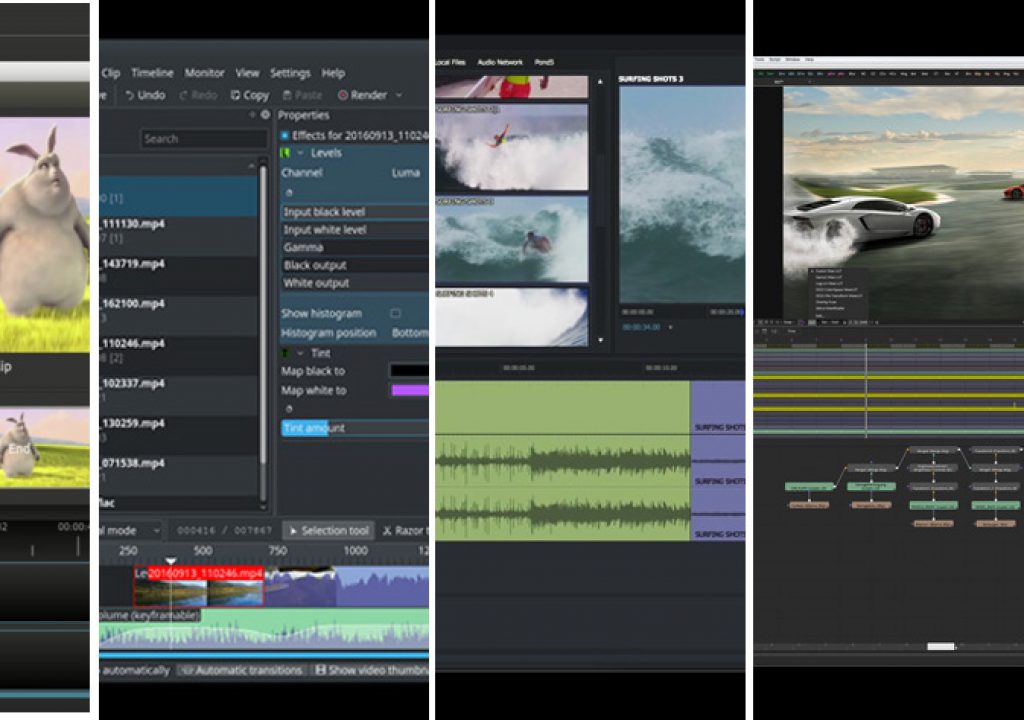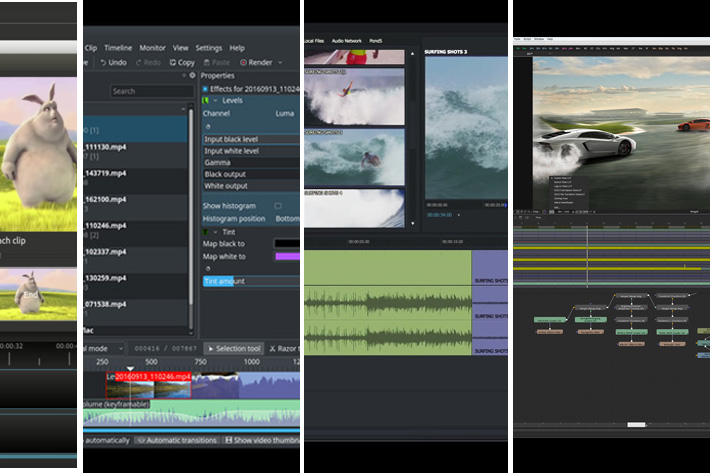
If you’ve just arrived to the world of video, chances are that names like DaVinci Resolve are more popular to you than Premiere Pro. Both are NLEs, but there is a huge difference between them: price. DaVinci Resolve is FREE.
The number of NLEs available on the market has not changed much since 2015, but some of the contenders have moved to a position that makes them the most popular choice these days. No, I am not talking about the heavy-weight names of the industry, Adobe Premiere Pro, Final Cut Pro X and similar “classic” software, but programs like DaVinci Resolve, which is, from where I see it, the most popular choice for many users.
In fact, while many professionals in the video editing industry have grown with a list of software as their reference, a new generation of users is not bound to use the same programs and is open to try new things, especially those NLEs that offer FREE versions, a trend that seems to be expanding.
These, let’s call them Freemium, products, of which DaVinci Resolve and Lightworks are examples, will be used to capture the attention of the market and build a community of users, while pointing to expansions or programs that offer more options. The truth, though, is that, for many users – especially in the case of DaVinci Resolve, the base program will be more than enough. Still, the simple fact of being able to play with adequate tools for video creation may help to define careers and move more people towards the higher end products.
One more note before the listing. I left aside the most common programs available in the market for the general public and looked for software that aims to satisfy the needs of advanced users in areas as video editing, color grading or special effects and compositing. Again, it should be noted that this is not an exhaustive guide, but a starting point for readers to use in their search for alternatives. Still, some of the names mentioned here are, as far as I know, the most popular, for reasons you will understand reading the following lines and, even better, trying them.
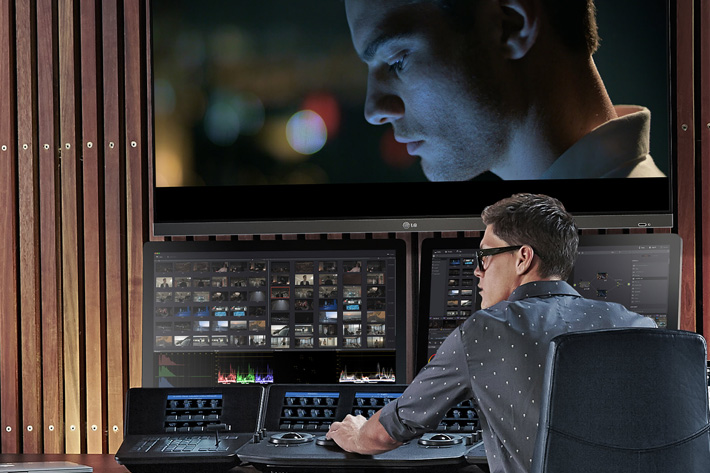
DaVinci Resolve 12.5: It’s getting better
Let me pick the title of a song, Getting Better, recorded by the Beatles (Lennon-McCartney) for the 1967 album Sgt. Pepper’s Lonely Hearts Club Band, as the title for this program from Blackmagic Design. It makes complete sense to classify DaVinci Resolve as a NLE that is getting better all the time. So much better, in fact, that many have moved to it, and a lot of people are using the FREE version, which is, according to what is heard from everybody, a very capable solution for everything from video editing to coloring.
After all, coloring was always an important aspect of DaVinci Resolve (as it was for the original Leonardo…) so it makes sense that Blackmagic Design develop a whole NLE around. The promise of the program is simple: experience professional non-linear editing with Hollywood’s most powerful color corrector.
While there are differences between the FREE and the paid versions, the truth is that many professionals are using the FREE version, as it offers, as Blackmagic Design puts it, a “a full professional editing and color grading system that is suitable for independent users working on SD, HD and Ultra HD projects.” The complete program is available for Mac, Linux and Windows. The DaVinci Resolve FREE edition, though, is only available for Mac and Windows.
Constantly updated, the DaVinci Resolve 12.5.4 is the most recent version of the software. The number of new functions added is huge, so instead of listing them here I invite you to visit Blackmagic Design’s page, check the info on new features and download the program. To give you an idea of the excitement the program creates let me repeat here what Grant Petty, CEO, Blackmagic Design said right before IBC 2016, where version 12.5.2 was presented. He said: “We have so many incredible ideas for DaVinci Resolve and we are extremely pleased to be able to offer so many new features to this update! Customers simply love DaVinci Resolve and the response has been overwhelming, especially from editors that are switching to Resolve for the first time. This update is the direct result of customer feedback and Blackmagic Design engineers are working harder than ever to deliver the features customers want. We hope that customers benefit from our commitment and our promise to build the world’s best editing and color correction software!”
As the Beatles sang “It’s getting better all the time”.
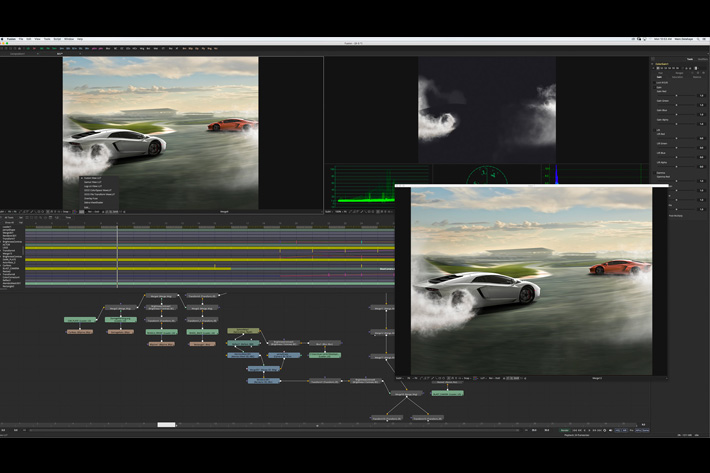
Fusion 8: A Nice Pair
Let me use the name of a Pink Floyd compilation – re-issuing their first two albums, The Piper at the Gates of Dawn and A Saucerful of Secrets -, from 1973, for this note on Fusion 8. It makes sense, as Fusion and DaVinci Resolve make A Nice Pair.
Although Fusion 8 is not a NLE, it makes sense to have it in this list, as Fusion represents the ideal companion to DaVinci Resolve. Both programs are from Blackmagic Design and Fusion 8, which has a Studio version priced at $995, also offers a FREE version, meaning you an have both a NLE and a compositing software without spending a dime, if you do not need the features from the commercial versions.
Presented as “the world’s most advanced compositing software for visual effects artists, broadcast and motion graphic designers and 3D animators.” Fusion, which has been used on thousands of Hollywood’s biggest blockbusters and hit television shows to create their groundbreaking visual effects, was developed over a period of 25 years. The program offers, according to Blackmagic Design, “an easy and powerful node based interface so you can construct complex effects simply by connecting various types of processing together. That’s super easy and extremely fast! You get a massive range of features and effects included, so you can create exciting broadcast graphics, television commercials, dramatic title sequences and even major feature film visual effects!”
Fusion 7 was available for Windows but Fusion 8, announced at NAB 2015, is available for Linux, Mac and Windows. Give it a try by downloading version 8.2, available now.
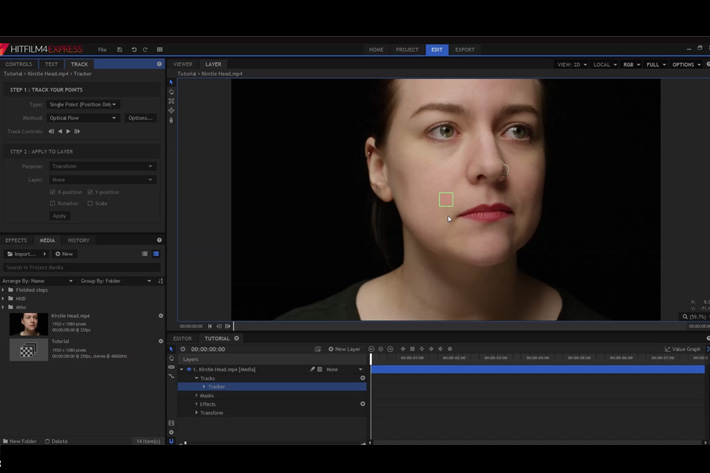
HitFilm 4 Express: New Kid in Town
New Kid in Town, a song by the Eagles – with Glen Frey on vocals – from their 1976 studio album Hotel California is a title that fits well to this program, which is the youngest NLE around, developed during the last five years.
HitFilm 3 Express is a free video editor and visual effects compositor. It shares the editing and compositing core technologies with its big brother, HitFilm Pro 2017, which costs $349 in a bundle with Ignite Pro 2017.
With a community of nearly 800,000 users worldwide, HitFilm Express continues to suggest the same to new users: you can edit videos. You can create titles. You can design visual effects. All without spending any money. And when you’re ready for more power, you’ve got super-flexible upgrade options.
HitFilm 4 Express is a good example of one of a new generation of tools that appeals to a generation born watching YouTube and Vimeo videos. I reviewed HitFilm 3 Express at ProVideo Coalition, and called it “The Lightroom of NLEs”. I wrote, then, that “for a new generation of indie cinematographers – or older ones willing to explore new content – HitFilm 3 Express may well be the starting point, an exploring platform leading them to the complete version.
The creators of the program say that they’ve “had enough of new and young filmmakers having to choose between cheap and nasty or expensive and good” software. HitFilm 3 Pro is our answer for people who know what they want to make. Indie filmmakers, freelance VFX and mograph artists and professionals looking to expand their plugin toolkit. You know who you are, and you know why you use HitFilm 3 Pro.”
HitFilm 4 Express is available for Mac and Windows. Give it a try; download the FREE version.
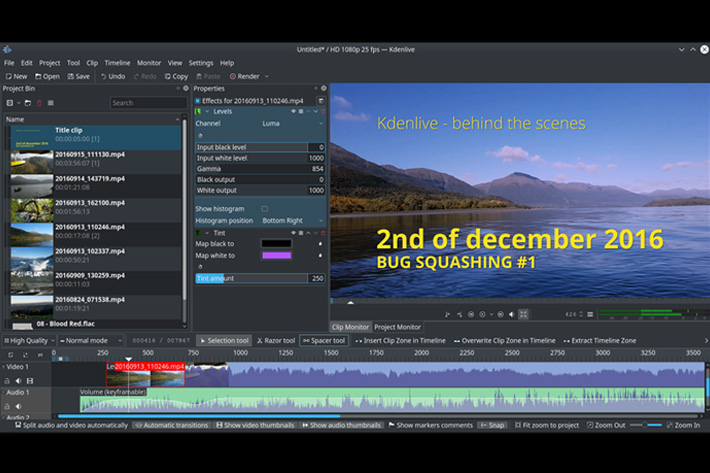
Kdenlive: Like a Rock
The aim of the this editor is to become one of the best video tools for the community. When I read this I instantly thought of Like a Rock, a song from Bob Seger, from his 1986 album Like a Rock. Yes, I know the lyrics have nothing to do with the aim of this NLE, but the mind has some unique ways to make connections.
Kdenlive 16.12 RC was released early December this year, for a “Bug squashing day” that would allow users to help… killing bugs. Kdenlive is a free, open-source video editor primarily aimed at the GNU/Linux platform, but also works on BSD and MacOS X. It is currently being ported to Windows as a GSOC project.
Kdenlive is an acronym for KDE Non-Linear Video Editor. The program supports DV, AVCHD and HDV editing. Conceived to answer all needs, from basic video editing to semi-professional work, the video editor relies on several other open source projects to work.
The creators of this FREE software project understand that modern filmmakers need to mix different kinds of media, including video, audio and images, so Kdenlive is built upon MLT and ffmpeg frameworks, which provide unique features to mix virtually any kind of media.
Offering an intuitive and powerful multi-track video editor, including most recent video technologies, the editor aims to become one of the best video tools for the community. Through the MLT framework, Kdenlive integrates many plugin effects for video and sound processing or creation. Furthermore Kdenlive brings a powerful titling tool, a DVD authoring (menus) solution, and can then be used as a complete studio for video creation, aspects that are important to users that like to have it all in one single program.
To find more about the FREE software and download it, visit Kdenlive website.
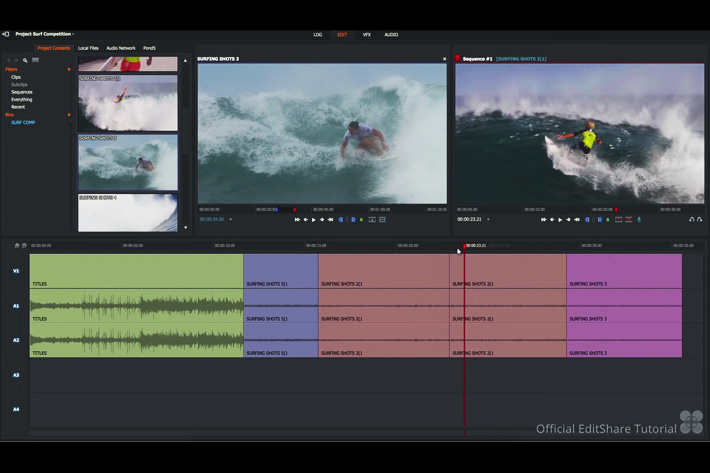
Lightworks: The Show Must Go On
Lightworks is the “old” NLE here, with over 25 years associated with the history of filmmaking. Because of that, it deserves, to have a classical title: “The Show Must Go On”, a song co-written by Leo Sayer and David Courtney that became a hit in the United States in 1974, performed by Three Dog Night.
Lightworks completely justifies the title I chose, because just recently it announced the public beta of version 14, which introduces some drastic changes, one of them an interface closer to the one used by many modern NLE. Yes, EditShare knows the show must go on. Some other changes were introduced in one NLE that continues to be praised by many of Hollywood’s top names. Lightworks, is a full-featured editor with all the power, performance and features you would expect, with support for all major professional broadcast formats from SD, HD, 2K and Red 4K files.
Having made its name on the Windows platform, the program from EditShare extended to Mac and Linux on Lightworks 12. Lightworks Free is the zero-cost version of Lightworks, and it is available for everyone. Lightworks Free has all the power of Lightworks, although it has a limitation: exports to Vimeo only at 1080p resolution.
The paid version, Lightworks Pro, comes with different options: you can go for a monthly ($24.99) or annual subscription ($174.99) or buy the software ($437.99). Find more info on Lightworks website. Also remember to download the FREE version and try it. The final version 14 of Lightworks will be available in January 2017, according to EditShare.
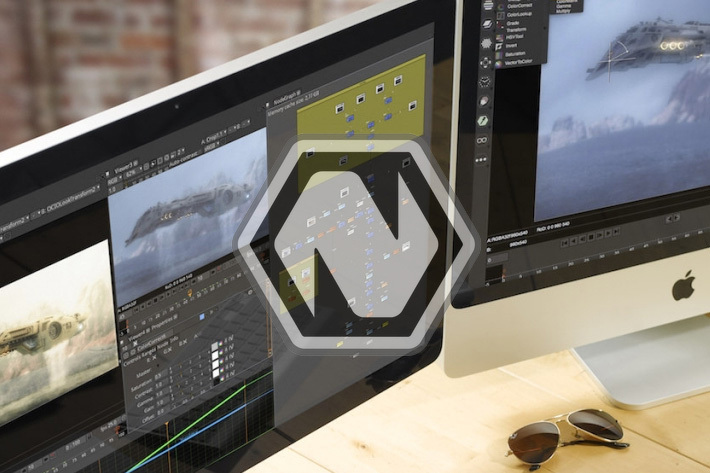
Natron: La Solitude
Natron appears here as in the 2015 listing, although it is not a video editor, but a compositing software, an alternative to After Effects, some would say. I decided to keep it in this update because I believe it has a mission to fulfill. As for a song, as it comes from France, I would suggest La Solitude, from Léo Ferré.
Natron is a free open-source, cross-platform compositing software, created as a tool for people who needed it and that may felt left-aside by the software editors pricing plans: students and schools that may not be able to buy expensive software licenses.
Available for Windows, Linux and Mac, Natron offers an interface similar to Nuke. According to the creators of the program, it was chosen “so it is easy for artists to pick up Natron if they know how to use the industry standard.”
Developed by Inria, the French National Institute for computer science and applied mathematics, promotes “scientific excellence for technology transfer and society”, Natron serves another goal: allow scientists in computer vision/graphics to develop, test exchange and publish results easily on the platform. The primary motive, though, is to “create a wave of standardization for software interchanges. As of today, not only there isn’t any rock solid open-source compositor, but there isn’t any standard way for softwares to exchange data. If several facilities are working together, they may face a wall when trying to share videos, images, LUTs or any other data. One great mission of free open-source softwares is to aim to standardise practises so everyone can create and share their creation together.”
Although it is FREE, recently Inria provides a full range of commercial support and services provided by researchers and engineers specializing in computer vision and computer graphics. They also offer ticket-based support, available on-line and integrated in Natron, custom features through the production of a commercially licensed release of Natron customized for the clients needs, which includes all of the features of the open source version and the additional features needed by each client. Training and on-site support are also available.
To find more about Natron and download the FREE program, visit Natron’s website.
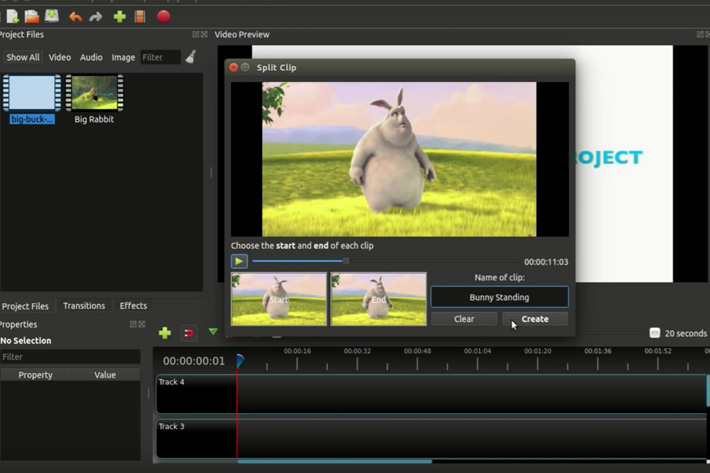
OpenShot Video Editor: Last of the Independents
Reading about this software makes me think of one song and one legend of rock and blues. The song is Last of the Independents and the musician is Rory Gallagher. The lyrics of this 1979 track from the Live At Montreux LP do not have much to do with the NLE OpenShot, but the title fits the idea one gets reading about the software.
The OpenShot Video Editor is a Linux pioneer when it comes to NLEs that has grown to other platforms as well. This FREE, open-source video editor recently launched a new version, 2.1 with lots of improvements. Created in 2008, by Jonathan Thomas, the program is the solution to a problem. When Jonathan, a software developer, installed Ubuntu (Linux) he was amazed but felt the need for a video editor and could not find any that would suit his needs: easy to use, powerful and stable. So he decided to create one.
Although faced with some problems, as he barely knew Linux or programming for Linux, and had no idea how to mix video & audio via code, Jonathan managed to create a program that allows “you to mix your videos, photos and music or audio files, to create the film you have always dreamed of”.
Eight years later OpenShot Video Editor is a reference within the community. Linux was the only operating system supported on the version available in 2015, but now there is even a beta for Windows 64 bit, besides downloads for Windows, Mac and Linux.
Presented as the professional video editor for Linux (and now also available for other platforms), OpenShot Video Editor is available to download from OpenShot’s website. Check it and download the FREE OpenShot Video Editor now!
Last Notes
So, this is a brief guide to the FREE NLEs and video editing software for 2017. For this edition I opted to relate each program to a musical theme, as I found interesting, when browsing after news of each program, that the words used to describe some of the programs made me think of specific songs. If you dare to explore the list of NLEs, do also a search for the music. Who knows, you might find some new background music for when you’re working.

Filmtools
Filmmakers go-to destination for pre-production, production & post production equipment!
Shop Now